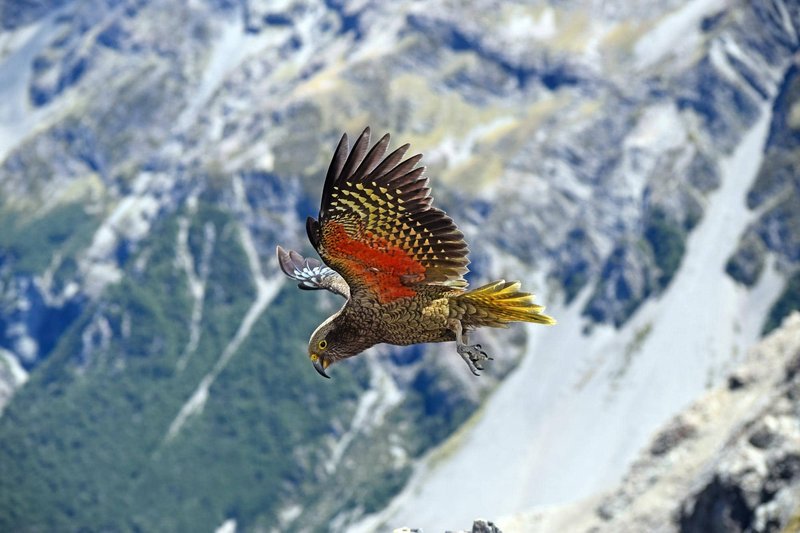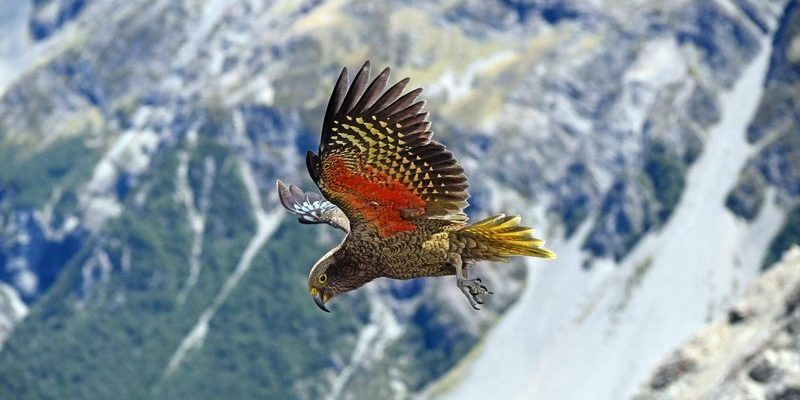
Have you ever wondered what it would be like to meet a parrot that’s not only playful but also incredibly intelligent? Welcome to the world of the Kea, a stunning green parrot native to New Zealand. Known for their curiosity and mischief, these amazing birds are like the clowns of the avian world. They can often be found in the stunning southern Alps, where they thrive in the unique mountainous environment.
The kea, with its vibrant green feathers and unique personality, has become a beloved symbol of New Zealand’s wildlife. They are not just any parrots; they are incredibly adaptable creatures, known for using their sharp minds to solve problems and play games. If you’ve ever seen a dog learn a trick, you’ll get a sense of how these birds approach life with a sense of fun and adventure.
Physical Characteristics of the Kea
Kea are medium-sized birds, measuring about 48 cm (19 inches) in length. Their striking green plumage is complemented by a lighter underside, and they have a distinctive orange flash under their wings that becomes visible when they fly. Their beak is strong and curved, perfectly suited for their omnivorous diet, allowing them to crack nuts and even tear open tough fruits.
One of the most captivating features of the kea is their large, expressive eyes. These birds exhibit excellent vision, which they use to navigate their rugged environment and locate food. Their feet are also strong and agile, allowing them to climb steep rock faces effortlessly. This combination of strength and agility makes the kea a master of its alpine home.
Their physical characteristics, however, do not only contribute to their survival; they also play a significant role in their social behaviors. With their impressive vocalizations and ability to communicate, keas can convey a range of emotions, making it evident they are more than just pretty birds. They exhibit complex social structures and often engage in playful interactions with one another, highlighting their unique personalities.
Kea Habitat and Distribution
You might be surprised to learn that keas are mostly found in the mountainous regions of New Zealand’s South Island. Their habitat includes alpine meadows, forests, and even the rocky slopes of the Southern Alps. This environment is rich with potential threats and challenges, yet the kea has thrived here for centuries. They have adapted wonderfully to this rugged terrain, finding niches in the ecosystem that few other birds can exploit.
In terms of elevation, keas can be found at altitudes ranging from 400 meters (1,312 feet) to over 2,000 meters (6,562 feet), showcasing their remarkable ability to handle extreme weather conditions. These birds are well adapted to the harsh climates and can often be seen playing in the snow during winter. One fascinating aspect of their habitat is the availability of food in both summer and winter. They eat a wide range of items, from seeds and fruits to insects and small animals, making them opportunistic foragers.
Kea have developed behaviors that make them highly successful in their habitats. They often follow humans, especially those working or hiking in the mountains, as they have learned that people can inadvertently provide food. This interaction has both positive and negative impacts on their survival, as it can lead to playful encounters but also increases their risk of becoming overly dependent on human food sources.
Kea Diet and Feeding Habits
The kea has a fascinating diet that reflects its adaptability. As omnivores, these birds consume a wide variety of foods, including fruits, seeds, nuts, and even carrion. Their strong beaks allow them to crack open tough food items like the seeds of the native kahikatea tree, which they absolutely adore. This diverse diet not only supports their health but also plays a crucial role in their ecosystem as they help disperse seeds.
What’s particularly interesting is how keas use their intelligence to solve problems related to finding food. They are known for their clever techniques to access food, such as using their beaks to pry open containers or even working together to outsmart humans. This is where things get interesting! Watching them figure out how to get to a food source can be just as entertaining as the most skillful circus act.
In addition to foraging alone, keas exhibit social feeding behaviors. They often forage in groups, which can enhance their safety from predators and increase the chances of finding food. This social aspect of their feeding habits emphasizes the importance of community among these birds. Their interactions during feeding time reveal their playful nature, as they often engage in games and antics with one another, making meal times a spectacle to witness.
Social Behavior of the Kea
The social structure of keas is captivating. They are known for living in groups, which allows them to share information about food sources and protect each other from potential threats. You could say that keas are social butterflies—or in their case, social parrots! Their interactions are marked by calls, body language, and play, reflecting their intelligence and emotional depth.
One remarkable aspect of kea behavior is their tendency to engage in play. They enjoy sliding down snowbanks, playing with objects, and even teasing other animals. This playfulness is not just for fun; it helps them develop important survival skills. Observing keas in their natural environment shows how their social interactions contribute to their overall well-being and survival.
Moreover, keas are known for their vocalizations, which play an essential role in their social interactions. Each bird has its unique call, and these sounds can convey a range of messages, from alarm to excitement. This vocal complexity is a testament to their intelligence, further distinguishing them from other bird species.
Conservation Status of the Kea
Currently, the kea is classified as a vulnerable species due to habitat loss, predation from introduced species, and human interference. While these birds are celebrated for their adaptability, they face significant challenges in the modern world. Conservation efforts are underway to protect their habitats and raise awareness about their plight.
One of the most pressing issues affecting the kea is the introduction of predators such as stoats and rats, which pose a significant threat to their nests and young. Conservation groups are actively working to mitigate these threats by trapping invasive species and protecting kea habitats. Engaging local communities in these efforts is crucial, as they can provide support and help monitor kea populations.
Public awareness and education are essential components of kea conservation. Many organizations run programs to educate visitors and locals about the importance of protecting this unique species. By sharing stories and experiences, we can inspire more people to take action and contribute to the conservation of the kea and its habitat.
Interesting Facts About the Kea
| Common Name: | Kea |
| Scientific Name: | Nestor notabilis |
| Size: | 48 cm (19 in) |
| Weight: | Approximately 1 kg (2.2 lbs) |
| Habitat: | Alpine regions of New Zealand |
| Diet: | Omnivorous (fruits, seeds, nuts, insects) |
| Life Span: | Up to 50 years in captivity |
| Social Structure: | Highly social, live in groups |
FAQ
What is the kea’s primary habitat?
The kea primarily inhabits the mountainous regions of New Zealand, particularly the Southern Alps. They thrive in environments characterized by alpine meadows and rocky slopes, which provide them with ample opportunities for foraging and nesting. Their ability to adapt to various elevations—from 400 meters to over 2,000 meters—demonstrates their resilience and cleverness in surviving in harsh conditions.
Are keas endangered?
Kea are considered a vulnerable species due to various threats including habitat loss, predation from introduced species, and human interference. Conservation efforts are in place to protect their populations and habitats, but keas still face significant challenges in the modern world. Efforts to educate the public about these amazing birds are crucial for their survival.
What do keas eat?
Kea have a diverse diet that includes fruits, seeds, nuts, and even small animals. Their omnivorous nature allows them to adapt to food availability in their mountainous habitat. They are clever foragers, often using their strong beaks to access food that other birds might not be able to reach. This adaptability contributes significantly to their survival in the wild.
How do keas socialize?
Kea are highly social birds that thrive in groups. They communicate using a variety of vocalizations and engage in playful behaviors, which strengthen their bonds with one another. Their social interactions not only enhance their well-being but also help them navigate their environment more effectively, as they share information about food sources and potential dangers.
What threats do keas face?
One of the main threats to keas is predation by introduced species such as rats and stoats, which pose significant risks to their nests and young. Habitat loss due to human development and climate change also impacts their populations. Conservation efforts are focused on mitigating these threats and ensuring the survival of this unique species.
How long do keas live?
In captivity, keas can live for up to 50 years, but their lifespan in the wild tends to be shorter due to various environmental challenges. Factors such as predation, food availability, and habitat conditions can all influence their lifespan. Conservation efforts aim to improve these conditions to help increase their longevity in natural habitats.
Can keas be kept as pets?
While keas are fascinating birds, they are not suitable as pets. Their social and environmental needs are complex, requiring large spaces to roam and interact with their kind. Additionally, in many places, it is illegal to keep native wildlife as pets, and efforts are better directed towards protecting them in their natural habitats.
How intelligent are keas compared to other parrots?
Kea are often noted for their exceptional intelligence, rivaling that of other highly regarded parrots like African greys and macaws. Their ability to solve complex problems, use tools, and engage in play demonstrates their cognitive abilities. Studies have shown that keas can learn from experience and even imitate behaviors, making them truly remarkable animals.
What role do keas play in their ecosystem?
Kea play a significant role as scavengers and seed dispersers within their ecosystems. Their omnivorous diet helps control insect populations and contributes to the health of various plant species by dispersing seeds. By maintaining balance in their habitat, keas are vital to the ecological health of New Zealand’s mountainous regions.
How often do keas breed?
Kea typically breed once a year, usually between August and December. They nest in tree cavities or cliffs, where the female lays a clutch of 4 to 6 eggs. The young are cared for by both parents until they are independent. Breeding success can be affected by environmental factors, such as food availability and predation.
Why are keas known as “the clowns of the mountains”?
Kea are often referred to as “the clowns of the mountains” due to their playful, curious nature and their tendency to engage in entertaining antics. Their social behavior, intelligence, and love for exploration make them delightful to observe, creating an image of joyful mischief in their alpine habitat.

